alto flute
All scores that include a part for at least one alto flute.
Haydn - Fugue from Op.20 No.2, arr. for Flute Quartet
 Fugue from Op.20 No.2, by Franz Joseph Haydn
Fugue from Op.20 No.2, by Franz Joseph Haydn
Arranged for Flute Quartet by John W. Pratt (originally for strings)
Score and Parts for Flute 1, Flute 2, Alto Flute, and Bass Flute, PDF $14.99
Haydn's development of the string quartet, of which he was the father no less than of the symphony, reached maturity with his "Sun" quartets Op.20. The finales of three of the Op.20 quartets are fugues, and are regarded as highly important because they set the standard for contrapuntal texture in quartets. They are as lively and fun as any other Haydn finale, and all four instruments share the action. Transposed up a fourth, the finale of Op.20 No.2 suits the range of a flute quartet with some adaptation, mostly for the bass flute. It is a blast to play. —JWP
Score, 12 pages; Flute 1 part, 3 pages; Flute 2 part, 3 pages; Alto Flute part, 3 page; Bass Flute part, 2 pages; Total,30 pages.
PreviewHaydn - Fugues from Op.20 No.5 and No.6, arr. for Flute Quartet
 Fugues from Op.20 No.5 and No.6 by Franz Joseph Haydn
Fugues from Op.20 No.5 and No.6 by Franz Joseph Haydn
Arranged for Flute Quartet by John W. Pratt (originally for strings)
Scores and Parts for Flute 1, Flute 2, Alto Flute, and Bass Flute, PDF $21.75
Haydn’s quartets through Op.20 made him the father of the string quartet no less than of the symphony. Three of the finales of the Op.20 quartets are exuberant fugues with multiple subjects (Haydn “soggetti”) ... four subjects in No.2, two in No.5, and three in No.6. John Pratt has arranged these lively fugues for flute quartet; this edition includes two of the fugues, those from Op.20 No.5 and No.6, while the Op.20 No.2 fugue has been published separately. A group of four flutes is well suited to the kittens-on-the-keys feel of Haydn’s Op.20 fugues, and they are a blast to play. For the arrangements in this publication, the No.5 fugue has been transposed up a major third and the No.6 fugue up a minor third to bring them into better range for flutes.
Scores, 20 pages; Flute 1 parts, 4 pages; Flute 2 parts, 4 pages; Alto Flute parts, 4 pages; Bass Flute parts, 4 pages; Total,46 pages.
PreviewHaydn - Op.1, No.1- arr. Flute Quartet
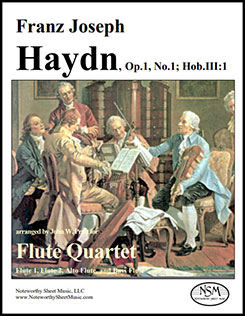 Quartet, Op.1, No.1, by Franz Joseph Haydn
Quartet, Op.1, No.1, by Franz Joseph Haydn
Arranged for Flute Quartet by John W. Pratt (originally for strings)
Score and Parts for Flute 1, Flute 2, Alto Flute, and Bass Flute, PDF $15.99
The earliest quartets of Franz Joseph Haydn are not precursors of the later works wherein he developed the form and style of the classical string quartet, but rather divertimenti written for four friends when he was about 25. Most of these early works have five movements: fast, minuet/trio, slow, minuet/trio, fast; and their slow movements feature beautiful, elaborate, gently accompanied melodies.
The divertimento style and instrumental character of these early pieces does not evoke strings specifically or necessarily, and thus arrangement for other instruments is natural and might expand enjoyment of these wonderful first significant Haydn works to other players and audiences. In John Pratt’s arrangement of Haydn’s Op.1, No.1 (Hob.III:1), most of the range issues for flutes were solved by transposition up a step, a few more by exchanging the two inner voices in places or by octave transpositions. This lovely, effective arrangement is for a flute quartet consisting of two concert flutes, alto flute, and bass flute; the edition is available exclusively from Noteworthy Sheet Music.
Score, 19 pages; Parts for Flute 1, Flute 2, Alto Flute and Bass Flute, 5 pages each; Total, 46 pages.
PreviewHaydn – Adagio from Symphony No.24 – trans. Solo Flute and Flute Choir
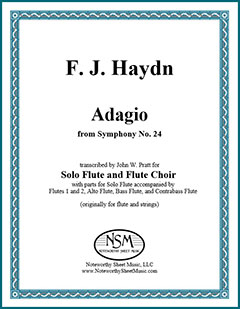 Adagio from Symphony No.24 by F. J. Haydn
Adagio from Symphony No.24 by F. J. Haydn
Transcribed for Solo Flute accompanied by Flute Choir, by John W. Pratt (originally for flute and strings)
Score and Parts for Solo Flute, Flutes 1 and 2, Alto Flute, and Bass Flute/Contrabass Flute, PDF $7.99
Haydn wrote his Symphony No.24 in 1764. Its second movement is a beautiful Adagio for flute solo accompanied by strings. The string parts are simple, with no double stops or extreme high notes, so they can be played comfortably by corresponding members of the flute family, except for a few low notes. This transcription for flute choir is therefore straightforward except that the alto flute sometimes plays violin notes that C-flutes cannot play or can use support playing, and similarly the bass flute plays some viola notes instead of or in addition to the alto flute playing them. Notes taken from the cello in its lowest octave have been raised an octave for bass flute, but there are fewer than one might expect. Perhaps one reason is that Haydn expected a (string) bass to be doubling the cello an octave lower, playing from the same part. If a contrabass flute is available, it can double the bass flute similarly, serving even more to enrich the sound. —adapted from JWP’s preface to the edition
Listen to a computer-generated audio sample.
Score, 5 pages; Parts for Solo Flute, 2 pages; Flutes 1 and 2, 2 pages; Alto Flute, 1 page; Bass Flute/Contrabass Flute, 1 page; Total 19 pages.
PreviewHaydn – Hob. II:21 – arr. Flute Quartet
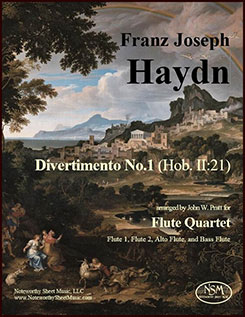 Divertimento No. 1 (Hob. II:21; Op. 2 No. 3) by Franz Joseph Haydn
Divertimento No. 1 (Hob. II:21; Op. 2 No. 3) by Franz Joseph Haydn
Arranged for Flute Quartet by John W. Pratt (originally for string quartet plus 2 horns)
Score and Parts for Flute 1, Flute 2, Alto Flute, and Bass Flute, PDF $11.97
excerpted from John W. Pratt’s © preface to the edition:
“Haydn (1732-1809) is credited with developing the classical forms of both the string quartet and the symphony, starting from the loose structures and permissive instrumentation of Baroque instrumental music. … His first string quartets are his Opus 1 Nos. 1-4 and 6, and Opus 2 Nos. 1-6, thus eleven. Opus 1 No. 5 is somewhat later, added to make a set of 6, apparently a perfect number in music publication as well as in mathematics. Opus 2 Nos. 3 and 5 are quartet arrangements of two divertimentos including also two horns and listed in the Hoboken catalogue as II:21 and 22 … The spirit and spiritedness of the two divertimentos suit them to flute quartet, as does the distribution of activity. In addition, a flute quartet combines the unified timbre of a string quartet with the wind sound of the horns, while the early string quartets do not exploit the string sound per se. Transposition up a step puts the cello and viola parts of Hob. II:21 mostly within the bass and alto flute ranges and makes the violin parts if anything more comfortable for C flutes.”
There are 5 movements in total: I-Allegro molto, II-Minuet, III-Adagio, IV-Minuet, and V-Finale Allegro. To get some sense of how the Op. 2 No. 3 quartet works with flutes in lieu of strings, listen to this computer-generated audio clip of the first movement—realizing it will of course sound considerably better played in-person on real instruments.
Score, 11 pages; Flute 1 part, 6 pages; Flute 2 part, 6 pages; Alto Flute part, 5 pages; Bass Flute part, 5 pages; Total, 38 pages.
PreviewHaydn – Hob. II:22 – arr. Flute Quartet
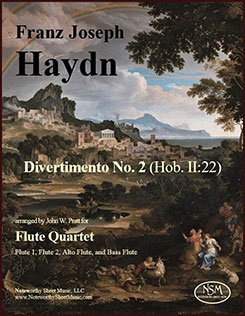 Divertimento No. 2 (Hob. II:22; Op.2, No.5) by Franz Joseph Haydn
Divertimento No. 2 (Hob. II:22; Op.2, No.5) by Franz Joseph Haydn
Arranged for Flute Quartet by John W. Pratt (originally for string quartet plus 2 horns)
Score and Parts for Flute 1, Flute 2, Alto Flute, and Bass Flute, PDF $10.97
This is the second of Haydn’s two divertimenti, Hob. II:21 and II:22, that John Pratt has arranged for flute quartet, scored for two C-flutes, alto flute, and bass flute. Both divertimenti were written originally for string quartet plus two horns, but were later adapted by others as quartet-only versions identified as Opus 2, No.3 and No.5. Please see the text excerpted from Mr. Pratt’s preface to his arrangement of Haydn’s Divertimento No.1 (Op.2, No.3) for additional information that applies to both these works. There are 5 movements in Op.2, No.5: I-Presto, II-Minuet, III-Largo, IV-Minuet, and V-Finale Presto. Listen to this computer-generated audio clip from the second movement Minuet to get a sense of how the quartet sounds with flutes in lieu of strings.
Score, 10 pages; Flute 1 part, 4 pages; Flute 2 part, 4 pages; Alto Flute part, 4 pages; Bass Flute part, 3 pages; Total, 28 pages.
PreviewHaydn – Symphony 13 - arr. for Multiple Flutes
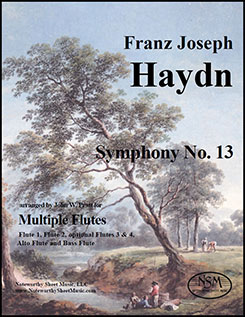 Symphony 13, by Franz Joseph Haydn
Symphony 13, by Franz Joseph Haydn
Arranged for Multiple Flutes by John W. Pratt
Score and Parts for Flutes 1-4, Alto Flute, Bass Flute; PDF $23.95
This arrangement of Haydn’s Symphony No.13 is for a flute ensemble of any size including at least one bass, one alto, and two concert flutes. Third and fourth concert flute parts are also provided, and all parts can be doubled at will. If a contrabass flute is available, it can double the bass flute, serving to deepen and enrich the sound. The second movement is a beautiful Adagio cantabile, originally for solo cello accompanied by strings, which transcribes nicely for alto flute accompanied by the rest of the flute family. The trio of the symphony’s third movement has a delightful solo flute part with only string accompaniment. A large flute ensemble would be about the size of Haydn’s core orchestra at the time this symphony was composed; in our arrangement, Haydn’s original key has been raised a minor third to better suit the natural range of a flute ensemble.
Score, 17 pages; separate parts for Flute 1, Flute 2, Flute 3, and Flute 4, 6 pages each; Alto Flute part, 7 pages; Bass Flute part, 6 pages; Total, 68 pages.
PreviewKalliwoda - Concertino - Alto Flute
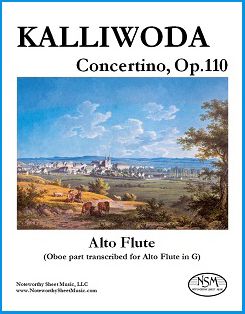 Concertino, Op.110, by J. W. Kalliwoda
Concertino, Op.110, by J. W. Kalliwoda
Transcribed for Alto Flute by C.A.Vater
Alto Flute Part ― PDF $6.99
Johann Wenzel Kalliwoda (1801‒1866) was a Bohemian violinist, orchestra conductor, and prolific composer who wrote numerous compositions, including operas, symphonies, various works for violin and orchestra, piano pieces, and chamber music works. He was considered a significant composer in his day, especially for pieces written early in his career, and his music received the praise of Robert Schumann. Kalliwoda was immensely popular and a favorite of American concert-going audiences in the first half of the 19th century.
His Concertino, Op.110, for oboe and orchestra was first published by Schott in 1841. An arrangement of the work for oboe and piano is available on imslp.org, in addition to an orchestral score and parts for oboe, violins I and II, violas, cellos, and basses. Like many of Kalliwoda's earlier compositions, the Concertino is highly melodic and energetic. We created a transcription of the solo oboe part for alto flute that gives alto flutists an opportunity to experience first-hand the joy of playing this style of classical 19th century bravura work, for which the alto flute is well-suited. Perhaps it should be pointed out that Theodore Boehm, who developed the modern alto flute in G during the mid-1850's, intended that the alto become a new instrument in its own right, utilized in a variety of musical roles and characterized by a unique quality of sound. Indeed, we think Boehm likely would have approved of our creating new opportunities, such as this transcription of the Kalliwoda Concertino, to show off the alto flute's versatility and the alto flute performer's virtuosity.
We provide our alto flute part only; appropriate parts for piano or orchestral accompaniment may be obtained as free pdf downloads from public domain resources, such as imslp.org.
Alto Flute part, 7 pages; Total, 10 pages.
PreviewMendelssohn - On Wings of Song - Alto Flute & Piano
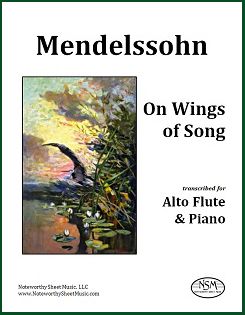 On Wings of Song, Op.34, No.2, by Felix Mendelssohn
On Wings of Song, Op.34, No.2, by Felix Mendelssohn
Transcribed for Alto Flute and Piano by C.A.Vater
Alto Flute Part and Piano Score, PDF $5.99
Having made significant contributions as a poet, essayist, journalist, and critic, Christian Johann Heinrich Heine (1797-1856) is considered one of the great German writers of the 19th century. Many of his romantic poems were chosen as the text for Lieder by such eminent composers as Schubert, Schumann, and Brahms. The Heine poem Auf Flügeln des Gesanges, which translates into English as On Wings of Song, was set to music by Felix Mendelssohn and published as No. 2 of six songs for voice and piano constituting his Opus 34. Auf Flügeln des Gesanges became one of Mendelssohn's most famous art songs, and remains popular to this day. Arrangements and transcriptions of the music have been created for small orchestra, flute and guitar, flute and piano, violin and piano, two violins, cello and piano, treble choir, and piano solo, among others. With its charming, simple melody and narrow pitch range, On Wings of Song is highly accessible and understandably a favorite of vocal and instrumental soloists of all levels. Our transcription is in the key of G, and the song is especially mellow and lovely when played on alto flute.
Alto Flute part, 1 page; Piano Score, 4 pages; Total, 8 pages.
Preview=========================================================
We also offer a professionally-printed hard copy edition of On Wings of Song for $10.18 plus a shipping and handling fee. Please use the Contact Us form to let us know which hard copy publication(s) you would like to purchase, along with your contact information and USPS mailing address. We will then send you a PayPal invoice for the sale and, once we receive notice from PayPal that you have paid for the item(s), we will ship your music to the address provided. We do not ship outside of the USA, due to high postage fees.
=========================================================
Mozart - Concerto in D Major - Alto Flute
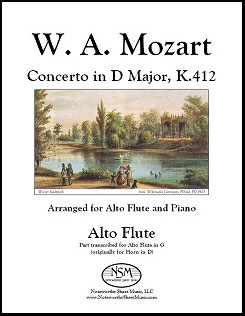 Concerto in D Major, K.412, by W. A. Mozart
Concerto in D Major, K.412, by W. A. Mozart
Transcribed (from horn and piano arrangement) for Alto Flute by C.A.Vater
Alto Flute Part, PDF $3.99
Mozart's Concerto for Horn in D major for Horn and Orchestra is scored for solo horn in D, with two oboes, two bassoons, and strings. Henri Kling (1842-1918), horn player, composer, conductor, and professor, arranged the concerto for horn and piano. We used the Kling arrangement as the source from which to create a transcription of the horn part for alto flute. The piano score is in the public domain and available as a free pdf download from other sources such as imslp.org/.
The Concerto in D major, K.412 is a short work of approximately 8-10 min duration, consisting of only two movements - an Allegro and a Rondo Allegro. The movements are light and joyous, and pose no particular technical challenges to the alto flute player. The written range is quite limited, extending only from D5 to E6. Thus, this piece can be played by less advanced students as well as by more experienced alto flutists.
Alto Flute part, 4 pages of music; Total, 8 pages.
Preview